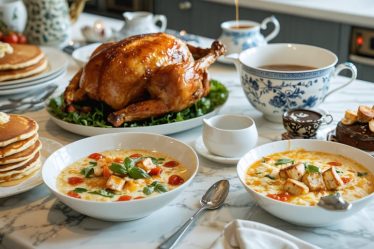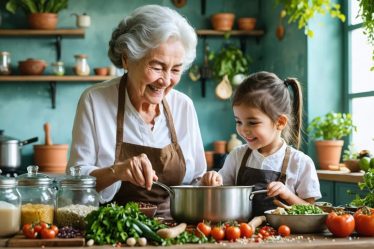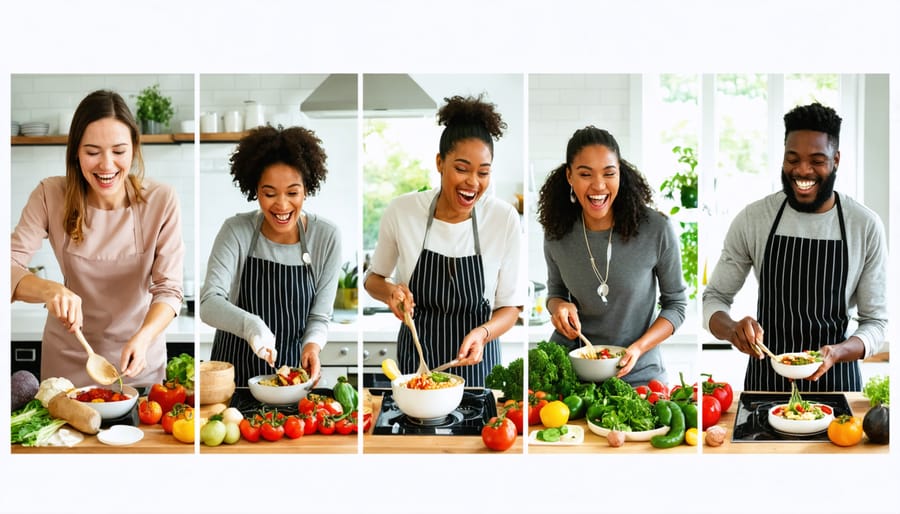
Transform your kitchen into a vibrant virtual gathering space where distance disappears and culinary creativity thrives. Virtual cooking events have revolutionized how we connect, learn, and share our passion for food in an increasingly digital world. Whether you’re a seasoned chef looking to share your expertise or someone eager to bring friends and family together for an interactive experience, online cooking classes offer a unique blend of entertainment, education, and social connection.
Picture this: Twenty smiling faces on your screen, all chopping, sautéing, and learning together while sharing stories and laughter across time zones. From corporate team-building sessions to intimate family gatherings, virtual cooking events create meaningful connections through the universal language of food. They’ve become more than just a pandemic-era necessity – they’re now a dynamic way to explore global cuisines, master new techniques, and create lasting memories, all from the comfort of your own kitchen.
Ready to spice up your social calendar with an engaging virtual cooking experience? Let’s dive into everything you need to know about hosting and participating in these digital culinary adventures that bring people together, one recipe at a time.
Why Virtual Cooking Events Are the New Way to Connect
Beyond Traditional Dinner Parties
While traditional dinner parties hold their charm, virtual cooking events offer unique advantages that make them increasingly appealing in our connected world. For starters, you can bring together friends and family from different cities, countries, or even continents – something that would be impossible with a traditional gathering. I recently hosted a virtual cooking session where my sister in London and my best friend in Sydney cooked alongside me in New York – a truly global kitchen experience!
These digital gatherings also eliminate common hosting hurdles like limited space, extensive cleanup, or the need for multiple place settings. Plus, everyone gets to enjoy the fruits of their labor in the comfort of their own home, perfect for those with dietary restrictions or specific serving preferences.
Virtual cooking events can be more budget-friendly too, as each participant purchases ingredients for their own portion only. They’re also ideal for busy schedules, eliminating travel time and making it easier to fit into a weekday evening. The casual, learn-as-you-go atmosphere often creates more engaging conversations and genuine connections, as everyone shares in the excitement (and occasional mishaps!) of cooking together, even when physically apart.
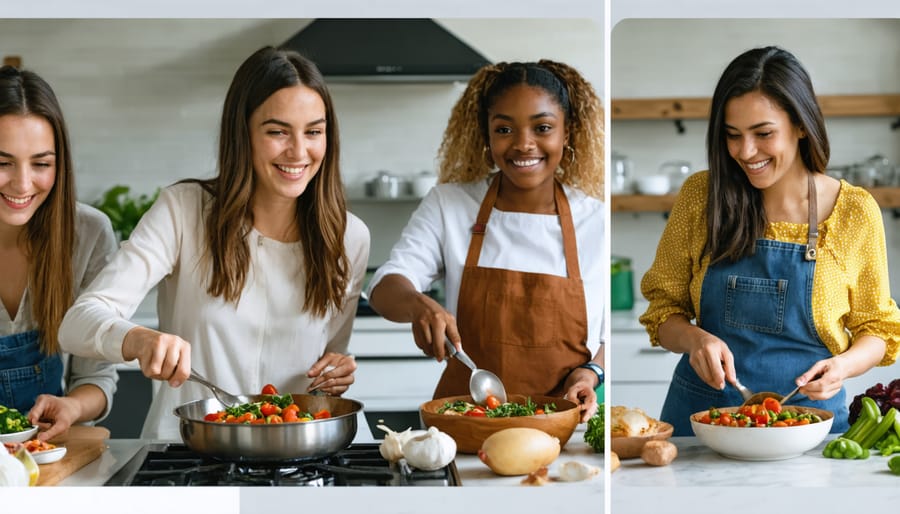
Creating Lasting Memories Online
Virtual cooking events create more than just meals – they forge connections that transcend physical boundaries. When we cook together online, we’re not just following recipes; we’re creating a shared mindful cooking experience that brings us closer despite the distance.
The joy of seeing a friend’s face light up when their soufflé rises perfectly, or laughing together over a spilled ingredient, creates authentic moments that become cherished memories. These digital gatherings often lead to deeper conversations as we chop, stir, and simmer together, sharing stories about family recipes or discussing life’s ups and downs over virtual chef’s tables.
Many of our community members have reported that virtual cooking sessions have helped them maintain and even strengthen relationships during times when meeting in person wasn’t possible. From celebrating birthdays with long-distance family members to hosting weekly cooking dates with friends across the country, these online experiences have evolved into meaningful traditions that participants look forward to.
The photos and videos captured during these sessions become digital keepsakes, while the recipes shared become part of each participant’s personal collection, carrying the warmth of these shared moments into future cooking adventures.
Planning Your Perfect Virtual Cooking Event
Choosing Your Platform and Tech Setup
Getting your virtual cooking event’s technical setup right is crucial for a smooth and enjoyable experience. While it might seem overwhelming at first, I promise it’s easier than you think! Let’s break down the essentials to help you create your perfect virtual kitchen studio.
First, choose a reliable video platform that suits your needs. Zoom remains a popular choice for its ease of use and familiar interface, while Google Meet offers a free alternative with similar features. For more intimate cooking sessions, FaceTime works wonderfully if everyone has Apple devices.
Your essential kitchen technology setup doesn’t need to be fancy, but a few key elements will make a big difference. Position your device (phone, tablet, or laptop) at eye level using a stable stand or holder. Trust me, nothing kills the mood quite like a tablet taking a tumble into your sauce!
Lighting is your best friend here. Natural light works beautifully if you’re cooking during the day – just position yourself facing a window. For evening sessions, a simple ring light can transform your setup from dim to professional. Remember to test your audio beforehand; a bluetooth earbud can help keep your hands free while ensuring everyone can hear your instructions clearly.
Pro tip: Do a quick test run before your event. This helps you identify any blind spots in your camera setup or potential technical hiccups before your guests arrive.
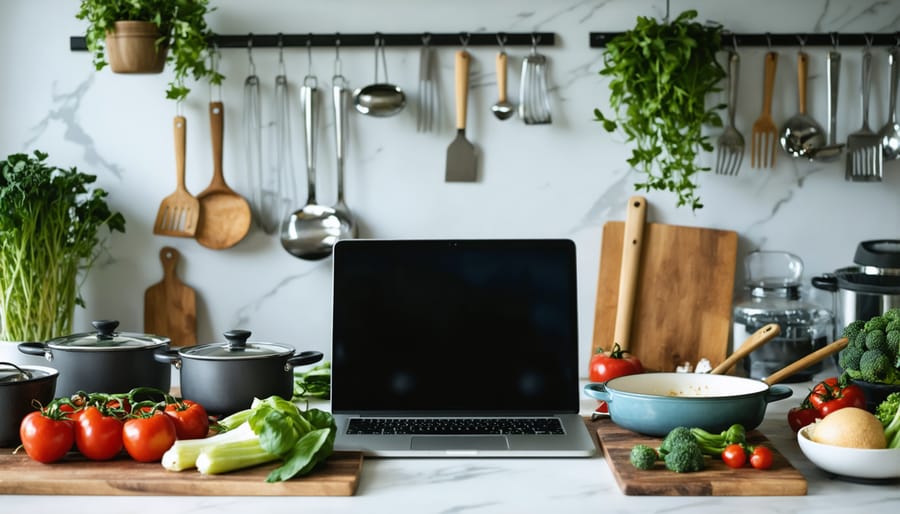
Selecting the Right Recipe
Choosing the right recipe can make or break your virtual cooking event. I learned this firsthand when I attempted to teach croissant-making online – let’s just say those tricky laminated layers weren’t exactly beginner-friendly! Now, I always recommend selecting dishes that strike the perfect balance between impressive and achievable.
Start by considering your participants’ cooking experience levels. Look for recipes that require basic kitchen equipment most people already own – not everyone has a stand mixer or food processor. One-pan dishes, sheet pan meals, and simple pasta dishes often work beautifully in virtual settings.
Time is another crucial factor. Aim for recipes that take 45-60 minutes from start to finish. This keeps everyone engaged without the session running too long. Consider recipes that have natural breaks for questions and discussion, like while sauce is simmering or vegetables are roasting.
Visual appeal matters more in virtual settings – choose dishes with vibrant colors and clear visual cues for doneness. Think colorful stir-fries, golden-brown baked goods, or beautifully layered salads. These make it easier for participants to follow along and gauge their progress.
Pro tip: Test your chosen recipe beforehand, paying special attention to potentially tricky steps that might need extra explanation. And always have a backup simple recipe ready, just in case technical difficulties cut into your cooking time!
Remember, the goal is to create a fun, stress-free experience that leaves everyone feeling accomplished and satisfied with their culinary creation.
Creating Your Event Timeline
Just like planning successful cooking events in person, creating a well-structured timeline is essential for your virtual cooking experience. I’ve found that the sweet spot for these events is typically 60-90 minutes, which keeps everyone engaged without feeling overwhelmed.
Start with a warm 5-minute welcome where participants can join and settle in. This is your chance to break the ice and create that cozy kitchen atmosphere we all love. Share a quick personal story about the recipe you’ll be making or ask participants to introduce themselves in the chat.
Next, dedicate 10 minutes to ingredient and equipment check. I always recommend doing this before diving in – there’s nothing worse than realizing halfway through that someone’s missing a crucial tool! Walk through the recipe overview during this time, highlighting any tricky steps or timing-sensitive elements.
The main cooking portion should take about 45-60 minutes. Break this down into clear segments, allowing time for questions between each major step. Remember to pause periodically and check that everyone’s keeping pace. I like to build in what I call “catch-up moments” – brief pauses where those who’ve fallen behind can get back on track.
End with a 10-15 minute show-and-tell session where everyone can proudly display their creations. This celebration phase is crucial for building community and ensuring everyone leaves feeling accomplished. Consider adding a quick cleanup tips session – it’s these thoughtful touches that make planning successful cooking events truly memorable.
Making It Interactive and Engaging
Fun Ice-Breakers and Activities
Break the ice and build connections before diving into cooking with these engaging virtual activities! Start with a “Kitchen Show and Tell,” where participants share their favorite kitchen tool or a special ingredient and the story behind it. This always leads to wonderful conversations and helps everyone feel more comfortable on camera.
Try the “Ingredient Challenge,” where participants guess mystery ingredients by asking yes/no questions – it’s like 20 Questions but with foodie flair! Or play “Kitchen Scavenger Hunt,” giving everyone 30 seconds to find items like “something orange” or “your most-used spice.” These quick-fire activities get everyone moving and laughing.
For a personal touch, invite participants to share their “Recipe Memory,” a brief story about a dish that holds special meaning to them. I’ve found this activity creates beautiful moments of connection, even through screens.
Create teams for a “Recipe Trivia” session with fun food facts and cooking knowledge. Keep questions light and entertaining – no pressure! You can also do a “Pantry Fashion Show,” where everyone creates quirky outfits using kitchen items like aprons, pot holders, or even produce.
Remember to keep these activities brief (5-10 minutes each) and optional – some participants might prefer to observe rather than participate. The goal is to create a warm, welcoming atmosphere where everyone feels comfortable being themselves before the cooking begins.
Troubleshooting Common Challenges
Even the most carefully planned virtual cooking events can hit a few snags, but don’t worry – I’ve got solutions for the most common challenges you might face. When participants struggle with ingredient substitutions (we’ve all been there!), encourage creativity and keep a list of common alternatives handy. For example, if someone’s missing buttermilk, they can mix regular milk with a splash of lemon juice or vinegar.
Technical hiccups can be frustrating, but they’re usually easy to solve. Always do a quick test run before the event, and have participants position their devices where they can see both their workspace and the instructor clearly. Pro tip: suggest using a phone stand or propping up tablets with cookbooks for better viewing angles.
Timing differences between participants are totally normal – some will chop faster, others might need more time to knead dough. Build in buffer time for these variations and use waiting moments as opportunities for Q&A or sharing cooking tips. I once hosted an event where we turned an unexpected delay into an impromptu discussion about knife skills!
If audio issues arise, have participants use headphones to reduce echo and background noise. For those with unstable internet connections, recording the main demonstrations as backup can be a lifesaver. Remember to share written recipes beforehand so everyone can follow along even if they temporarily lose connection.
Most importantly, keep the atmosphere light and fun. Technical glitches and cooking mishaps often lead to the most memorable moments and genuine connections in virtual cooking events.
Special Theme Ideas for Virtual Cooking Events
Around the World Cuisine nights
Transform your virtual cooking events into a global culinary adventure by hosting themed “Around the World” nights! These international cooking experiences let participants explore international cuisines from the comfort of their own kitchens while building meaningful connections across borders.
Start by selecting a specific country or region for each session. I recently hosted an Italian night that was a huge hit – we made homemade pasta from scratch, and the shared experience of flour-covered counters and imperfect shapes brought so much laughter to our screens! Send ingredient lists and equipment needs at least a week in advance, including both authentic options and accessible substitutes for hard-to-find items.
Create an immersive experience by incorporating cultural elements beyond just cooking. Play traditional music in the background, share interesting facts about the region’s food history, or invite participants to dress up in themed attire. Consider partnering with local specialty stores that can create ingredient kits for participants to pick up.
To keep the flow smooth, start with a brief cultural introduction, demonstrate key techniques clearly, and build in natural breaks for questions. End each session with a virtual dinner party where everyone can showcase their creations and share stories. These cultural cooking nights often become monthly traditions, with participants taking turns suggesting countries to feature – from Morocco’s aromatic tagines to Japan’s precise sushi rolling techniques.
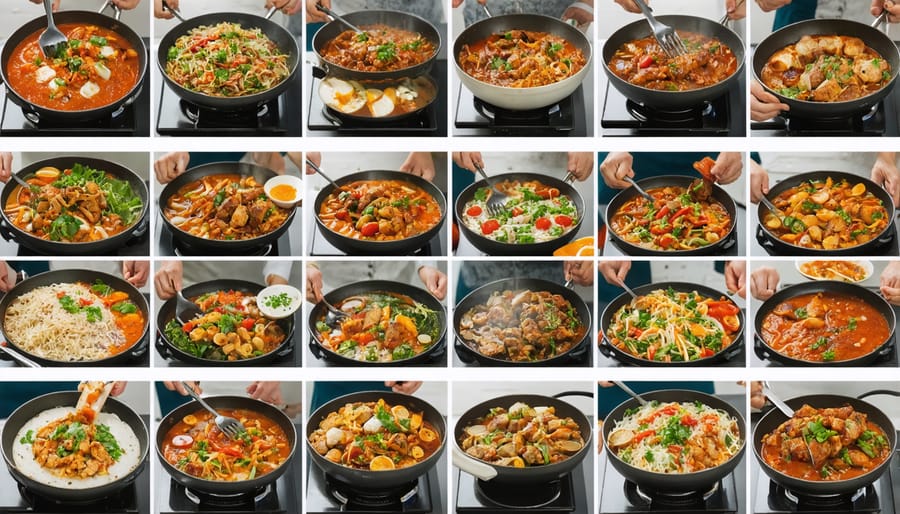
Seasonal and Holiday Cooking Parties
The holiday season brings endless opportunities to connect with loved ones through virtual cooking parties. I absolutely love organizing themed cooking events that celebrate different holidays throughout the year – it’s amazing how festive even a computer screen can feel with the right planning!
For Christmas, try hosting a cookie decorating party where everyone makes their favorite holiday cookies. Send out ingredient lists in advance, including different colored frostings and festive sprinkles. During Thanksgiving, coordinate a side dish workshop where participants each prepare a family favorite while sharing cherished memories and recipes.
Halloween offers spooky fun with themed treats like monster cookies or witch finger breadsticks. For Valentine’s Day, organize a chocolate-making session or couple’s cooking date night. Easter can feature springtime classics like hot cross buns or decorated Easter eggs.
Don’t forget cultural celebrations! Host a Lunar New Year dumpling-making party, a Diwali sweets workshop, or Hanukkah latke-making session. These events offer wonderful opportunities to learn about different traditions while creating delicious dishes together.
Make your event extra special by encouraging festive decorations in participants’ kitchens, playing themed music, and sharing holiday stories while cooking. Consider sending small holiday-themed cooking tools or ingredients to participants in advance – it adds a wonderful personal touch that makes virtual gatherings feel more connected and meaningful.
Remember to schedule these events well in advance, as calendars fill up quickly during holiday seasons. The joy of cooking together, even virtually, creates lasting memories and helps maintain cherished traditions across any distance.
Virtual cooking events offer a wonderful way to stay connected, learn new skills, and create lasting memories with friends, family, or colleagues, no matter where they are in the world. From casual weekend brunches to elaborate holiday feasts, these digital gatherings bring the joy of cooking into our connected world. By following the tips and guidelines we’ve shared, you can create an engaging, fun, and memorable experience that will have everyone asking when the next session will be. Remember, the key to success lies in thorough planning, clear communication, and maintaining a relaxed, inclusive atmosphere. Whether you’re a seasoned home chef or just starting your culinary journey, hosting a virtual cooking event is an enriching experience that brings people together in a uniquely modern way. So gather your ingredients, set up your camera, and get ready to create some kitchen magic – your virtual cooking adventure awaits!

